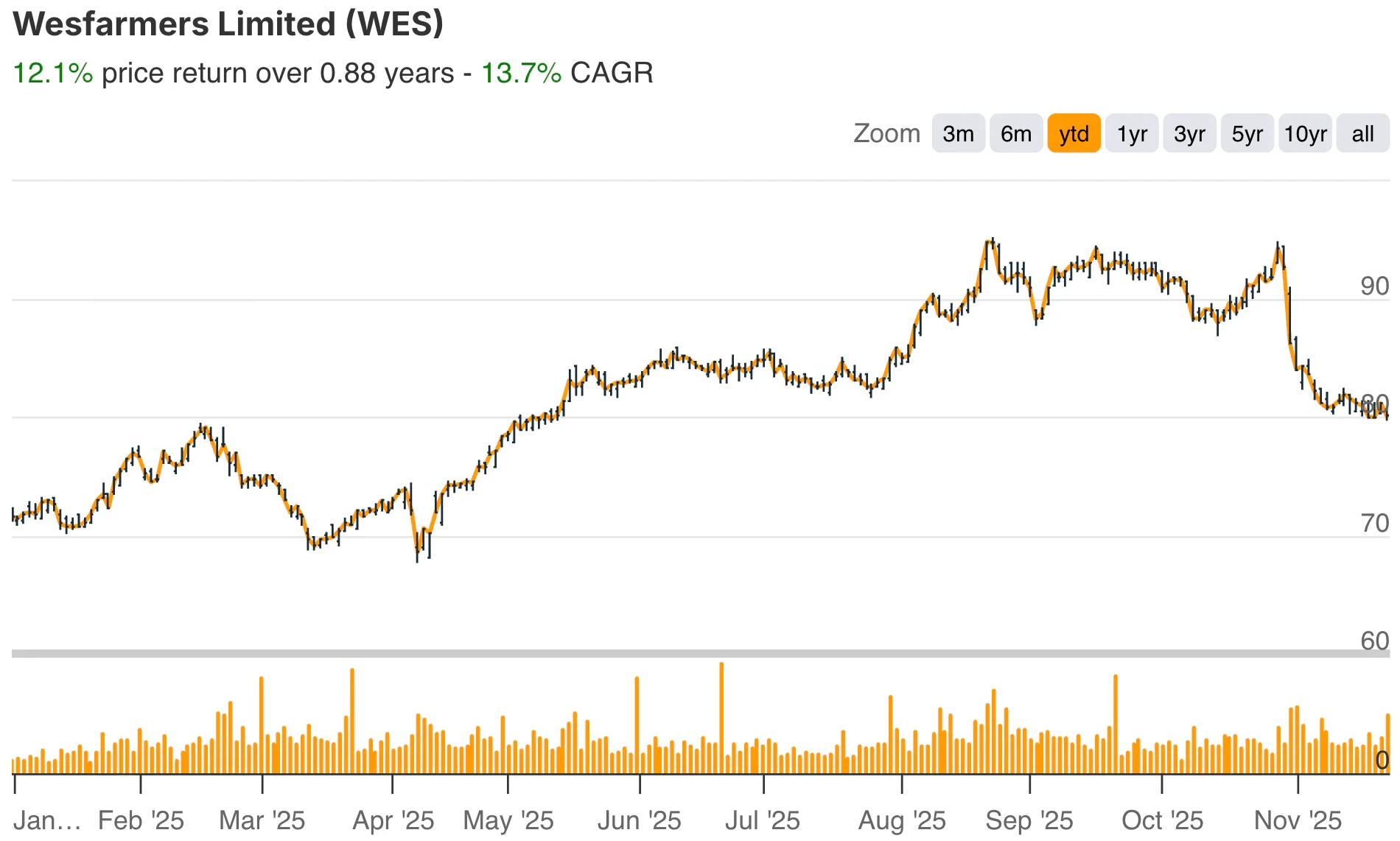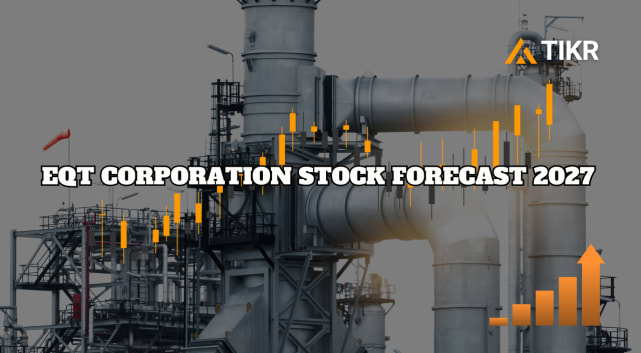Wesfarmers (WES) is a highly diversified Australian conglomerate, primarily known for its powerful retail divisions like Bunnings and Kmart Group. The company’s core strategy centers on maintaining retail leadership, pursuing operational excellence, and growing new platforms, particularly in the health sector. This deep portfolio diversification provides robust financial stability and resilience across economic cycles.
Discover how much upside your favorite stocks could have using TIKR’s new Valuation Model (It’s free) >>>
The full year 2025 results demonstrated “strong trading” and continued momentum, with underlying earnings increasing across the majority of its businesses. This strong performance was achieved despite the challenges posed by high inflation and rising living costs, which have impacted consumer confidence. The company achieved growth by leveraging its powerful digital and omnichannel retail execution.

Wesfarmers is now focused on strategically growing its new segment, Wesfarmers Health, while aggressively pursuing platform investment within its retail divisions. This strategy aims to leverage the success of its digital execution to capture further market share and ensure its core retail brands remain dominant heading into 2026.
Quickly value any stock with TIKR’s powerful new Valuation Model (It’s free!) >>>
Financial Story
Wesfarmers delivered stable revenue of 45.7 billion Australian dollars for the full year 2025, up 3.4% from the prior year. More importantly, earnings before interest and tax (EBIT), excluding significant items, rose 4.9% to 4.186 billion Australian dollars. This growth highlights effective management of margin and retail performance in the current inflationary environment.
| Metric | FY 2025 Outcome (Ex. Significant Items) | Comparison to FY 2024 | Notes |
| Revenue | 45,700m AUD | Up 3.4% | Broad-based growth across the portfolio. |
| EBIT | 4,186m AUD | Up 4.9% | Demonstrates effective margin management. |
| NPAT | 2,653m AUD | Up 3.8% | High-quality underlying earnings growth. |
| Operating Cash Flow | 4,568m AUD | Down 0.6% | Strong result, indicating high-quality earnings. |
| Basic EPS | 234.0 cps | Up 3.7% | Reflects disciplined capital returns. |
| Full-Year Ordinary Dividend | 206 cps | Up 4.0% | Maintained commitment to shareholder returns. |
Net profit after tax (NPAT), excluding significant items, reached 2.653 billion Australian dollars, a rise of 3.8% year-over-year. Operating cash flows remained strong at 4.568 billion Australian dollars, signaling high-quality earnings despite a slight 0.6% decrease. Basic earnings per share, excluding significant items, increased 3.7% to 234.0 cents per share, showing high-quality underlying performance.
The company reinforced its commitment to capital returns with a full-year ordinary dividend of 206 cents per share, up 4.0% from the prior year. Looking ahead, the valuation model projects a mid-case Revenue Growth (CAGR) of 4.0% and an EPS Growth (CAGR) of 5.7% over the forecast period.
Look up Wesfarmers’ full financial results & estimates (It’s free)>>>
Broader Market Context
The Australian economic environment remains supportive, driven by a strong jobs market and steady consumer spending, which forms the core backdrop for NAB’s lending and deposit businesses. This stable economic environment is critical for managing potential headwinds arising from slower global trade and inflation. The bank continues to navigate a mixed scenario characterized by both economic resilience and elevated credit risk across its asset classes.
However, the banking sector faces increased complexity due to sustained inflation and higher interest rates, which directly affect lending margins and lead to higher credit impairment charges. Global macroeconomic uncertainty, including ongoing geopolitical tensions, heightens the risk environment for Australian banks. This requires NAB to maintain constant vigilance and prudent financial planning, especially concerning its credit portfolio.
1. Retail Leadership and Digital Execution
Wesfarmers relies on the sheer dominance of its retail chains, Bunnings and Kmart Group, which form the financial backbone of the entire organization. Bunnings continues to excel by serving both the professional trade and the consumer home improvement markets, leveraging its expansive network. The Kmart Group, encompassing Kmart and Target, appeals powerfully to value-conscious shoppers, a critical advantage in the inflationary environment. This combined market leadership provides stability and scale that few domestic competitors can match.
These core retail divisions successfully leveraged platform investments to drive digital sales and enhance the customer experience. The continued shift toward an integrated omnichannel model ensures clients can seamlessly move between physical stores and online platforms.
This efficiency minimizes the cost to serve and captures high-margin sales across both physical and digital platforms. Investing in this digital capability is essential for retaining the current growth trajectory and defending market share against online pure-plays.
2. Strategic Growth in Health and Emerging Platforms
The company is strategically committed to developing Wesfarmers’ Health, positioning it as a significant future growth pillar outside of traditional retail. This involves targeted investments to build market share and operational scale within the health sector. Successfully building out this new vertical will further diversify the group’s earnings base and mitigate cyclical risks associated with traditional retail.
This diversification strategy focuses on long-term structural trends, such as the increasing demand for preventative healthcare and wellness services. Furthermore, the company continues to foster innovation within its existing industrial divisions, including Chemicals, Energy, and Fertilisers. This disciplined approach to capital allocation supports emerging platforms that promise superior returns beyond the core retail portfolio.
Value stocks like Wesfarmers in less than 60 seconds with TIKR (It’s free) >>>
3. Capital Efficiency and Shareholder Returns
Wesfarmers maintains a strong balance sheet and a disciplined approach to capital allocation, underpinning its reliable shareholder return policy. The company consistently prioritizes investing in its highest-returning businesses, namely Bunnings and Kmart, to maintain its competitive advantage. Maintaining strong operational efficiency across all divisions ensures that capital expenditure translates effectively into future earnings.
The consistent growth in the ordinary dividend, combined with the occasional capital management distribution, highlights the company’s commitment to rewarding shareholders. This balanced approach ensures the company retains sufficient capital for strategic growth and acquisition opportunities while providing dependable cash returns. The reliable dividend history makes Wesfarmers an attractive option for income-focused investors seeking stability.
The TIKR Takeaway

Wesfarmers’ chart shows a strong 18.4% price return over the last 11 months, reflecting robust investor confidence. The TIKR Valuation Model projects a mid-case total return of 21.5% over 4.5 years, resulting in a gentle but solid 4.4% annualized IRR.
This model suggests that while Revenue Growth (CAGR) is forecast to remain stable at 2.6%, the real earnings power comes from the sustained Net Income Margin forecast at 29.0%. For an analyst, TIKR illustrates that the stock is currently fairly valued, with its consistent performance and strategic growth in business banking already justifying the steady annualized return forecast. The investment thesis hinges on NAB’s ability to maintain its leading deposit franchise and execution efficiency.
Should You Buy, Sell, or Hold Wesfarmers Limited Stock in 2025?
Wesfarmers demonstrated strong execution and remarkable stability across its Australian franchise, delivering stable cash earnings and a lift in underlying profit. The bank’s leadership in business banking and its strong deposit growth provide excellent strategic foundations.
From a valuation perspective, the stock is trading close to what its consistent fundamentals suggest. The strong market performance of the last year indicates the bank is efficiently priced. Therefore, until the bank signals a major acceleration in growth or margin expansion, investors should be cautious with Wesfarmers and watch for a stable, fully franked dividend, while monitoring execution into 2026.
How Much Upside Does Wesfarmers Limited Stock Have From Here?
With TIKR’s new Valuation Model tool, you can estimate a stock’s potential share price in under a minute.
All it takes is three simple inputs:
- Revenue Growth
- Operating Margins
- Exit P/E Multiple
If you’re not sure what to enter, TIKR automatically fills in each input using analysts’ consensus estimates, giving you a quick, reliable starting point.
From there, TIKR calculates the potential share price and total returns under Bull, Base, and Bear scenarios so you can quickly see whether a stock looks undervalued or overvalued.
Find out what your favorite stocks are really worth (Free with TIKR) >>>
Looking for New Opportunities?
- See what stocks billionaire investors are buying so you can follow the smart money.
- Analyze stocks in as little as 5 minutes with TIKR’s all-in-one, easy-to-use platform.
- The more rocks you overturn… the more opportunities you’ll uncover. Search 100K+ global stocks, global top investor holdings, and more with TIKR.
Disclaimer:
Please note that the articles on TIKR are not intended to serve as investment or financial advice from TIKR or our content team, nor are they recommendations to buy or sell any stocks. We create our content based on TIKR Terminal’s investment data and analysts’ estimates. Our analysis might not include recent company news or important updates. TIKR has no position in any stocks mentioned. Thank you for reading, and happy investing!







